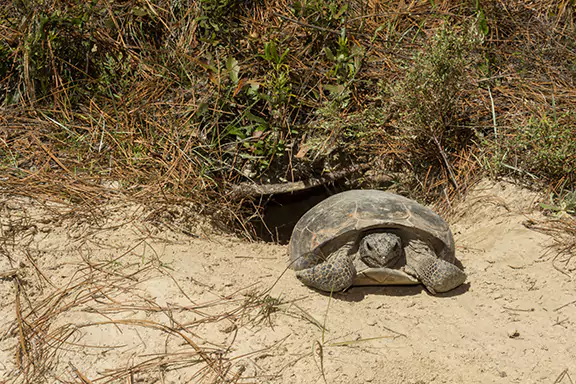Gopher tortoises are not just another wild animal found in Florida — they are a protected species with an essential role in the state’s delicate ecosystem. If you’ve ever seen one walking across a residential lawn or digging into sandy soil, you might have wondered if it’s okay to pick it up or move it. The answer is clear and important:
Yes, it is illegal to pick up a gopher tortoise in Florida unless you are properly authorized through a state-issued permit.
Whether you’re a homeowner, real estate developer, golf course manager, or in charge of land clearing for construction, it’s critical to understand the laws that protect these animals — and the serious consequences that come with violating them.
In this article, we’ll explain why gopher tortoises are protected, what the laws say, and how to get help if one is found on your property.
Why the Gopher Tortoise Is a Protected and Vital Species
Understanding the Gopher Tortoise's Role in the Ecosystem
The gopher tortoise is known as a keystone species because more than 350 other animals depend on its burrows for shelter and survival. These include gopher frogs, burrowing owls, and countless small mammals and insects. When a gopher tortoise digs a burrow — sometimes more than 40 feet long — it creates a habitat that helps maintain balance in the entire southeastern coastal plain ecosystem.
These tortoises are mostly found in Florida but also live in parts of South Carolina, Georgia, Alabama, and along the Mississippi River and Tombigbee Rivers. They thrive in longleaf pine ecosystems, pine flatwoods, dry prairies, and xeric oak hammocks, which offer well-drained sandy soils, broadleaf grasses, and open, sunny areas for burrowing.
Unique Features That Help Them Survive
Gopher tortoises are easily recognized by their dark brown shells, sturdy, elephantine hind feet, and flattened, shovel-like forelimbs perfect for digging burrows. These burrows provide insulation from extreme temperatures and protection from predators.
The gopher tortoise’s ability to engineer and maintain burrows is essential to the survival of other threatened wildlife species. This makes the tortoise a top priority for wildlife conservation commissions, the Fish and Wildlife Service, and the Gopher Tortoise Council, all of which work to monitor, protect, and manage the species and its habita
Florida Law: Why It’s Illegal to Pick Up a Gopher Tortoise
Gopher Tortoises Are Protected Under State and Federal Law
In Florida, the gopher tortoise is classified as a threatened species. That designation means it’s illegal to harass, capture, relocate, or harm a gopher tortoise—or even disturb its burrow—without proper authorization. The laws apply to everyone, including residential property owners, land developers, and construction contractors.
The species is protected under Florida law by the Florida Fish and Wildlife Conservation Commission (FWC) and is also supported by federal guidelines from the U.S. Fish and Wildlife Service. In some parts of the southeastern United States, especially in the western range, gopher tortoises are even federally listed under the Endangered Species Act.
Legal Consequences for Disturbing Gopher Tortoises or Their Burrows
Violations of gopher tortoise protections can come with steep fines and, in some cases, criminal charges. These penalties are enforced by both state and federal agencies. Here’s what can happen:
Fines ranging from hundreds to thousands of dollars per tortoise or burrow
Criminal misdemeanor charges, which may include court appearances
Potential project shutdowns for commercial developments and builders
Even indirect harm—like landscape maintenance, prescribed burning, or land clearing that unintentionally collapses a gopher tortoise burrow—can result in violations if performed without proper inspection or permitting.
Permits Are Required for Any Interaction
The only legal way to handle, relocate, or work around gopher tortoises is through a gopher tortoise relocation permit issued by the FWC. These permits are often required before starting any construction project, even on private land, if a tortoise burrow is present. The permitting process may include:
A habitat inspection by a trained wildlife professional
Documentation of gopher tortoise presence and burrow locations
Plans for humane relocation of tortoises to FWC-approved recipient sites
This is why working with experienced professionals who specialize in gopher tortoise services is crucial. Whether you’re preparing for a new development or managing an existing property, it’s your responsibility to ensure that the law is followed and threatened wildlife species are protected.
4 Common Activities That Can Harm Gopher Tortoises and Their Habitat
Unintentional Harm Happens More Often Than You Think
You don’t have to pick up a gopher tortoise to break the law. Many violations happen during normal activities that homeowners, builders, and landscape crews carry out without realizing a tortoise is nearby. That’s why it’s so important to know what to look for — and what to avoid — before starting any work on your land.
Here are the most common activities that can accidentally harm gopher tortoise populations and lead to violations under Florida wildlife conservation laws.
1. Land Clearing and Construction Without Inspection
Before starting any land development or landscape maintenance, Florida law requires checking the site for active gopher tortoise burrows. Failure to do so can result in damage to the tortoise or its home — and hefty fines.
Heavy equipment used for clearing, grading, or trenching can collapse gopher tortoise burrows buried just beneath the surface. Since these animals often live in well-drained sandy soils in sunny areas, they’re frequently found on land that seems ideal for building.
2. Mowing, Digging, or Prescribed Burns Without Precaution
Even routine yard work can be a threat. Mowing over burrow entrances, digging trenches, or setting prescribed fires without understanding where burrows are located can directly injure tortoises or destroy the homes they depend on for protection from extreme temperatures and predators.
Prescribed burning, when done improperly, may kill tortoises sheltering in shallow burrows, especially juvenile tortoises that can’t burrow as deep or move as quickly.
3. Attempting to Move a Tortoise Without a Permit
Whether you see a tortoise digging in your residential lawn, it is still illegal to pick up a gopher tortoise—even if your intentions are good. Only certified agents with relocation permits are allowed to handle tortoises legally.
Improper relocation can separate the tortoise from its tortoise habitat, disrupt breeding patterns, or spread diseases like upper respiratory tract disease, which is a serious threat to the species.
What if a gopher tortoise is on the road?
Per the FWC “You may help the tortoise cross the road by placing it out of harm’s way in the same direction that it was going. DO NOT take the tortoise with you or move it to a different area. Also, do not put your life in danger to move the tortoise.”
4. Ignoring the Signs of Tortoise Presence
Many property owners don’t recognize the signs of an active burrow. Gopher tortoise burrows often look like wide, flat holes with a half-moon shape at the entrance. They may be surrounded by disturbed sand and are usually found near low-growing plants such as gopher apples or in areas with broadleaf grasses.
If you ignore these signs and proceed with development or clearing, you risk destroying an active habitat, which is considered a violation under both state law and the federal register.

Permitting and Relocation: What to Do If You Have a Gopher Tortoise on Your Property
You Can’t Relocate a Gopher Tortoise Without a Permit
If you find a gopher tortoise or spot one of its burrows on your property, don’t touch it. Under Florida law, even moving a tortoise a few feet can result in a violation. The only legal way to relocate a gopher tortoise is through a Florida Fish and Wildlife Conservation Commission (FWC) issued permit, and it must be handled by a trained, authorized professional.
Whether you’re preparing for a residential landscaping project, building a new home, or managing a commercial development, the first step is a professional site inspection to determine if any gopher tortoise habitat is present. This process protects not only the tortoise but also you and your project from legal trouble.
Steps for Legal Gopher Tortoise Relocation
Here’s what the legal relocation process typically includes:
On-site survey: A wildlife professional will inspect the property for active burrows, tracks, and signs of tortoise presence.
Habitat assessment: The inspection covers surrounding conditions such as broadleaf grasses, low-growing plants, and well-drained sandy soils common to gopher tortoise areas like pine flatwoods, coastal dunes, or longleaf pine sandhills.
Permit application: If tortoises are present, a relocation permit must be submitted and approved by the FWC.
Relocation to approved sites: Tortoises must be safely relocated to state-approved, pre-qualified recipient sites that meet specific environmental criteria.
Monitoring and compliance: Once relocated, tortoises are monitored to ensure survival and adaptation to the new habitat.
All of this must be done by a qualified agent. Failing to follow the permit process — or attempting DIY relocation — is a direct violation of the laws protecting threatened wildlife species and can stop your project in its tracks.
Both Homeowners and Developers Are Responsible
Responsibility for legal compliance falls on both the landowner and the contractor. Even if you hire someone else to do the clearing or excavation, you are still legally accountable if protected wildlife is harmed. This applies to:
Private property owners
Real estate agents and investors
Commercial developers and builders
Golf course and resort operators
Anyone managing land in Florida’s southeastern coastal plain
If you’re unsure about the presence of gopher tortoises or how to proceed legally, it’s better to ask questions now than face fines later.
Protecting Gopher Tortoises Is the Law—and the Right Thing to Do
The gopher tortoise isn’t just another animal living on your land—it’s a protected species with a vital role in Florida’s ecosystems. Whether you’re a homeowner planning a small project or a developer overseeing large-scale construction, it’s your legal responsibility to avoid harming gopher tortoises or their burrows.
Picking up a gopher tortoise, disturbing its habitat, or failing to get proper permits can result in major fines, project delays, and long-term legal consequences. But with the right support, staying compliant is simple.
Need Help with Gopher Tortoise Relocation, Permitting, or Inspection?
If you believe a gopher tortoise may be living on your property or project site, don’t take chances.
Contact Premier Gopher Tortoise Services for:
Certified site inspections
Help with gopher tortoise permitting
Safe, legal relocation of tortoises
Expert advice on protecting threatened wildlife species
We work with residential property owners, developers, real estate professionals, and commercial land managers to keep projects moving while protecting Florida’s native wildlife. Don’t risk costly mistakes—let us help you do it the right way.

